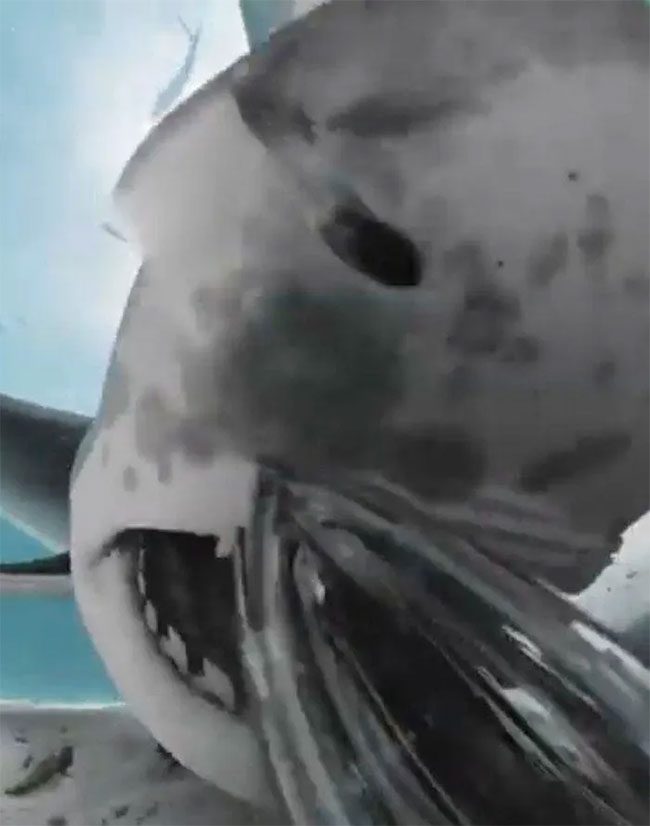Filmmaker, ocean lover, and conservationist Zimy Da Kid was in the midst of filming a documentary in the ocean when one of the sharks swimming around him decided to swim over and take a bite out of his camera equipment.
As shown in a 27-second video, the camera went quite deep into the shark’s mouth, capturing images of the shark’s razor-sharp teeth as well as the inside of its mouth and throat.
Upon closely examining the shark’s teeth, scientists discovered that this fierce creature’s dental structure contains fluoride, a key ingredient in modern human toothpaste and mouthwash, which helps prevent cavities and other dental issues. This explains why sharks are so effective at tearing apart their prey. Their teeth are perfectly designed for this purpose and are never susceptible to decay.
Interestingly, once you get past the menacing rows of teeth, the inside of the shark’s mouth appears very smooth and clean.
Realizing that the camera was not suitable for food and digestion, the shark eventually spat it out and swam away.
The camera used to capture these scenes is the Insta360 ONE X2 pocket action camera, valued at $390, capable of recording 360-degree footage at a resolution of 5.7K. Other features include an invisible selfie stick, waterproofing up to 10 meters, a stabilizer mode, FlowState stabilization, a super-bright touchscreen, and 360-degree audio with four built-in microphones.

The inside of the shark’s mouth appears very smooth and clean.
Zimy Da Kid expressed his hope that his underwater documentary could create an impact by encouraging people to appreciate and protect our planet and its inhabitants.
“As an artist, creator, and ocean lover, I truly believe that through filmmaking and photography, we have a vital role in conserving and advocating for the natural world,” he wrote on Facebook in January 2022. “Art has a unique power to evoke emotions within people, and once people start to love something, they begin to care for it and protect it. This is exactly what I want to achieve through my art!”
“I want to inspire other creators to use their skills and talents to create meaningful work, things that raise awareness, that not only evoke emotions but also educate people about the significant challenges nature faces today.”
“As an artist, there is no greater feeling than creating art with purpose. There is so much to lose in this world, which also means there is so much worth fighting for….”

A recent study conducted by the Global Shark Trends Project and published in Nature revealed that the number of sharks and rays living in the world’s oceans has decreased by over 70% since 1970. The primary reason for this rapid decline, according to the authors, is rampant fishing. During this period, the study found that “fishing pressure”—a concept used to calculate the ratio of sharks and rays caught by fishermen relative to their global population—has increased 18-fold. This is a frightening example of the extinction crisis occurring across the planet, which could have a significant impact on ecosystems worldwide if we do not change the situation.

The authors, hailing from various parts of the world and collaborating on the study for 10 years, collected data on the most common shark and ray species, all of which inhabit open waters far from the continental shelf. They aimed to assess the status of these species based on two indicators provided by the United Nations Convention on Biological Diversity.
The first, the Living Planet Index, tracks global population fluctuations of species since 1970, and the second, the Red List Index, monitors the extinction risk of species based on their population status and the threats they face in nature. These indicators are also linked to international goals for human prosperity. “These indicators contribute to assessing progress towards the United Nations’ biodiversity and sustainable development goals,” said Nathan Pacoureau, the lead author of the study and a biologist at Simon Fraser University in British Columbia.
The authors selected the 31 most common shark and ray species globally for their study. However, even after diving into heaps of scientific literature and previous government reports, they found they could only analyze the Living Planet Index for 18 of those species due to a lack of adequate historical population data for the remaining 13.
After gathering 57 datasets with time-specific information on 18 species, assessed by experts from the International Union for Conservation of Nature, the authors compiled a table detailing the population of each species for each year over the past 50 years. On average, the study showed that shark populations have declined by 71% since 1970, with an average rate of 18.2% per decade.

















































